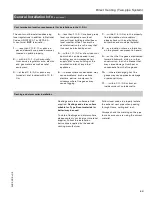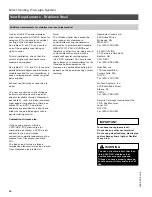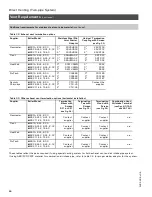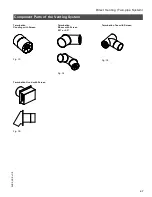
Combustion
air opening
Single Wall Venting (Room Air Dependent)
57
Venting - Single Wall (Room Air Dependent)
The single-wall venting system draws
combustion air from the boiler room.
Room/Combustion air
enters the
boiler at the boiler vent pipe adaptor
through an annular air gap. Flue gases
are discharged to the outdoors via
the single-wall pipe of the special
venting system.
Vent Requirements
Combustion air supply
This boiler requires fresh air for safe
operation and must be installed in a
mechanical room where there are
provisions for adequate combustion
and ventilation air.
There are no provisions available on the
Vitodens boiler to interlock it with an
external combustion air blower.
The Vitodens boiler is suitable for
sidewall, as well as vertical venting
using field supplied venting material.
The Vitodens 100-W and
Vitodens 200-W boilers are approved
for direct exhaust (non-sealed
combustion) operation in both,
horizontal and vertical arrangements.
Provisions for combustion and
ventilation air must be made in
accordance with CAN/CSA-B149.1 or
.2 Natural Gas Installation Codes
(latest edition) (for installations in
Canada) or in accordance with sections
for Combustion and Ventilation Air, of
the National Fuel Gas Code, ANSI
Z223.1 (latest edition)
or applicable provisions of local codes
(for installations in the U.S.A.)
Follow local codes to properly isolate
the vent pipe when passing through
floors, ceilings and roof.
Whenever possible, install boiler near
an outside wall so that it is easy to
duct fresh air directly to the boiler area.
Refer to national codes for duct sizing.
Round ducts may be used.
The boiler must be vented and supplied
with combustion air and exhaust vents
as described in this section. Ensure the
vent and combustion air supply comply
with these instructions.
The boiler location should never be
under negative pressure. Exhaust fans,
attic fans, or dryer fans may cause air
to be exhausted at a rate higher than
air can enter the structure for safe
combustion. Corrective action must be
taken to ensure enough air is availabe.
Never cover the boiler or store debris
or other materials near the boiler, or in
any way block the flow of adequate
fresh combustion air to the boiler.
If boiler is installed in a confined space
(a space with a volume of less than 50
cubic feet per 1000 Btu/h of gas input
for all fuel burning equipment) or
building layout is unusually tight,
adequate air for combustion must be
provided by two openings: one located
about 6” below the ceiling, the other
about 6” above the floor. When
communicating directly with the
outside, each opening must have a
minimum free area of one square inch
per 2000 Btu/h of gas input. When all
combustion air is provided by openings
in doors, etc. to adjoining spaces
having adequate infiltration, each
opening must have a minimum free
area of one square inch per 1000 Btu/h
of gas input, but not less than 100 in
2
.
You must know the free area of
louvers used to cover up the
combustion and ventilation openings in
closet installations. If you do not know
the free area, assume 20% for wood
louvers and 60-75% free area for metal
louvers. When using louvers, the
openings have to be made larger. For
example, a free 14” x 6” opening
becomes a 14” x 10” opening for a grill
containing metal louvers.
Continued on following page.
5
2
8
5
2
6
8
v
3
.8
Failure to provide an adequate supply
of fresh combustion air can cause
poisonous flue gases to enter living
space, which can cause severe
personal injury or loss of life.
WARNING
Do not store chemicals containing
chlorine or other corrosive materials
near the boiler, such as bleach,
cleaning solvents, detergents, acids,
hair spray, spray cans, paint thinners,
paint, water softener salt,
perchloroethylene, or carbon tetra
chloride.
Caution
Exposure to corrosive materials can
cause heat exchanger corrosion and
failure.
CAUTION
Summary of Contents for Vitodens 100-W WB1A-24
Page 78: ...78 5285 268 v3 8 ...
Page 79: ...79 5285 268 v3 8 ...
















































